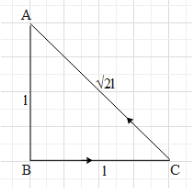
Three rods of identical cross-sectional area and made from the same metal form the sides of an isosceles triangle ABC right angled at B. The points A and B are maintained at temperatures T and $\sqrt 2 $T, respectively, in the steady state. Assuming that only heat conduction takes place, temperature of point C is
A. ${T_c} = \dfrac{{3T}}{{\sqrt 2 + 1}}$
B. ${T_c} = \dfrac{T}{{\sqrt 2 + 1}}$
C. ${T_c} = \dfrac{T}{{\sqrt 2 - 1}}$
D. ${T_c} = \dfrac{T}{{3(\sqrt 2 + 1)}}$
Answer
219.9k+ views
Hint: Assume that the temperature at point C, i.e. ${T_c}$, is higher than the temperature at point A but lower than the temperature at point B. Then apply a conduction formula for rate of heat flow and equate the rate through the rods BC and CA.
Formula used:
$\dfrac{{dQ}}{{dt}} = \dfrac{{kA({T_2} - {T_1})}}{l}$
where $\dfrac{{dQ}}{{dt}}$ is the rate of heat flow through a conductor of length l, cross section area A and conductivity k. T2 and T1 are the temperatures of the end points.
Complete answer:

Here, let us assume that the temperature at point C, i.e., Tc, is higher than the temperature at point A but lower than the temperature at point B. We know that heat flows from a point at higher temperature to a point that is at a lower temperature.
Therefore, the heat flow will be from point C to point A through rod AC and from point B to point C on the rod BC. Therefore, the heat flows from point B to point A via rods BC and CA.
Since it is given that the system is in steady state, the end point temperatures will be constant and the rate of flow of heat will also be constant. In addition, the rate of heat flow through BC is equal to rate flow of heat flow through CA.
$ \Rightarrow {(\dfrac{{dQ}}{{dt}})_{BC}} = {(\dfrac{{dQ}}{{dt}})_{CA}}$
Since both the rods are of the same metal, their conductivity is the same, i.e. k.
Also, it is given that the two rods have the same cross-sectional area.
Let the length of BC be l. Since it is an isosceles triangle, BC=AB=l.
Then, by Pythagoras theorem we get, $C{A^2} = {l^2} + {l^2} = 2{l^2}$
$ \Rightarrow CA = \sqrt 2 l$
Therefore
$ \Rightarrow \dfrac{{kA(\sqrt 2 T - {T_c})}}{l} = \dfrac{{kA(T - {T_c})}}{{\sqrt 2 l}}$
Solving we get ${T_c} = \dfrac{{3T}}{{\sqrt 2 + 1}}$
Note: The fact that the flow is constant and the heat only moves by conduction allowed us to use this formula for conduction. We must make the essential assumption that point C's temperature is between the temperatures of the other two places. If not, the rate of heat transfer would fluctuate.
Formula used:
$\dfrac{{dQ}}{{dt}} = \dfrac{{kA({T_2} - {T_1})}}{l}$
where $\dfrac{{dQ}}{{dt}}$ is the rate of heat flow through a conductor of length l, cross section area A and conductivity k. T2 and T1 are the temperatures of the end points.
Complete answer:

Here, let us assume that the temperature at point C, i.e., Tc, is higher than the temperature at point A but lower than the temperature at point B. We know that heat flows from a point at higher temperature to a point that is at a lower temperature.
Therefore, the heat flow will be from point C to point A through rod AC and from point B to point C on the rod BC. Therefore, the heat flows from point B to point A via rods BC and CA.
Since it is given that the system is in steady state, the end point temperatures will be constant and the rate of flow of heat will also be constant. In addition, the rate of heat flow through BC is equal to rate flow of heat flow through CA.
$ \Rightarrow {(\dfrac{{dQ}}{{dt}})_{BC}} = {(\dfrac{{dQ}}{{dt}})_{CA}}$
Since both the rods are of the same metal, their conductivity is the same, i.e. k.
Also, it is given that the two rods have the same cross-sectional area.
Let the length of BC be l. Since it is an isosceles triangle, BC=AB=l.
Then, by Pythagoras theorem we get, $C{A^2} = {l^2} + {l^2} = 2{l^2}$
$ \Rightarrow CA = \sqrt 2 l$
Therefore
$ \Rightarrow \dfrac{{kA(\sqrt 2 T - {T_c})}}{l} = \dfrac{{kA(T - {T_c})}}{{\sqrt 2 l}}$
Solving we get ${T_c} = \dfrac{{3T}}{{\sqrt 2 + 1}}$
Note: The fact that the flow is constant and the heat only moves by conduction allowed us to use this formula for conduction. We must make the essential assumption that point C's temperature is between the temperatures of the other two places. If not, the rate of heat transfer would fluctuate.
Recently Updated Pages
Electricity and Magnetism Explained: Key Concepts & Applications

JEE Energetics Important Concepts and Tips for Exam Preparation

JEE Isolation, Preparation and Properties of Non-metals Important Concepts and Tips for Exam Preparation

JEE Main 2021 July 25 Shift 1 Question Paper with Answer Key

JEE Main 2021 July 22 Shift 2 Question Paper with Answer Key

States of Matter Chapter For JEE Main Chemistry

Trending doubts
Understanding Uniform Acceleration in Physics

Understanding Atomic Structure for Beginners

Understanding Centrifugal Force in Physics

JEE Main Marking Scheme 2026- Paper-Wise Marks Distribution and Negative Marking Details

Degree of Dissociation: Meaning, Formula, Calculation & Uses

Understanding Average and RMS Value in Electrical Circuits

Other Pages
NCERT Solutions for Class 11 Physics Chapter 6 System Of Particles And Rotational Motion 2025-26

Understanding Entropy Changes in Different Processes

Common Ion Effect: Concept, Applications, and Problem-Solving

Understanding Excess Pressure Inside a Liquid Drop

NCERT Solutions For Class 11 Physics Chapter 12 Kinetic Theory - 2025-26

Motion In A Plane Class 11 Physics Chapter 3 CBSE Notes - 2025-26




